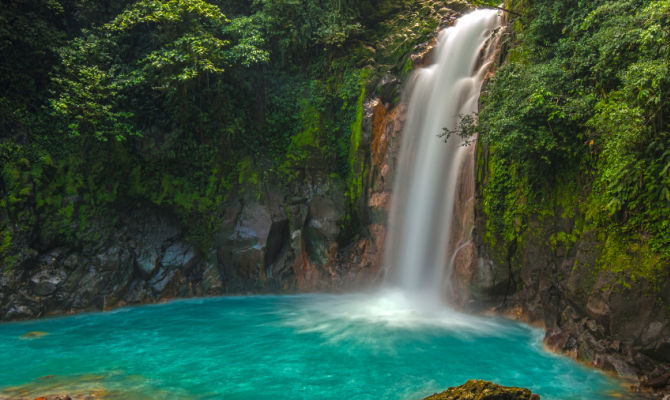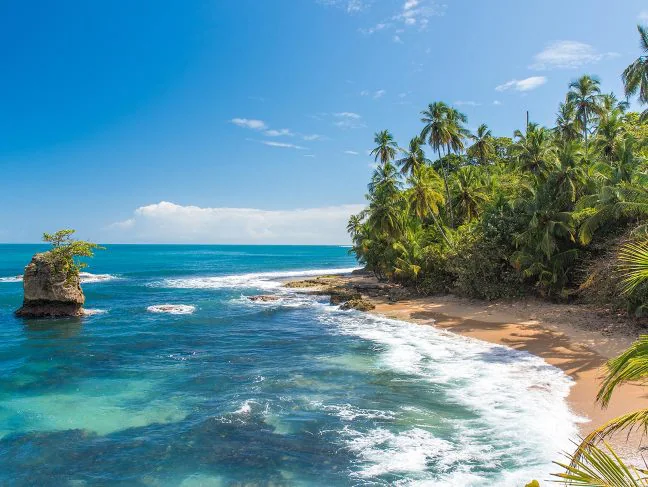Is Costa Rica or Mexico better? Let’s compare the two Central American countries
When it comes to choosing a travel destination, both Mexico and Costa Rica offer extraordinary experiences, but each of these countries has unique characteristics that make them special. In this article, we will explore why Costa Rica may be a better choice for travelers seeking pristine natural beauty, safety, sustainable tourism, and an exceptional quality of life. Through a direct comparison between these two jewels of Latin America, we will highlight Costa Rica’s strengths, helping you understand why it could be the ideal destination for your next trip.
Natural Beauties

When it comes to natural beauty, both Mexico and Costa Rica offer breathtaking landscapes, but Costa Rica stands out for its extraordinary biodiversity and its commitment to environmental conservation.
National Parks and Nature Reserves
Mexico boasts a number of notable national parks, such as Agua Azul Falls National Park and Cañón del Sumidero National Park, which offer spectacular scenery and thrilling adventures. However, Costa Rica surpasses Mexico in terms of the density and diversity of protected areas. With more than 25% of the nation’s territory dedicated to national parks and reserves, Costa Rica offers natural gems such as Corcovado National Park, often described as one of the most biologically intense places on the planet. Here, visitors can spot jaguars, tapirs and a wide range of bird species, an experience that is hard to match.
Unique Biodiversity
Mexico is known for its ecological diversity, from the coral reefs of Cozumel to the jungles of Chiapas. However, Costa Rica is home to approximately 5% of the world’s biodiversity, an impressive proportion considering its relatively small size. The rainforest of Tortuguero National Park, with its sea turtles that lay their eggs on the beaches, and the Monteverde Reserve, famous for its cloud forests and rare species, offer wildlife viewing experiences that are difficult to find elsewhere .
Paradise beaches
The beaches of Mexico, such as those of Cancún, Tulum and the Riviera Maya, are famous throughout the world for their beauty and the turquoise waters of the Caribbean. However, the beaches of Costa Rica are no different. Playa Tamarindo is popular for surfing, while Playa Conchal and Playa Flamingo offer crystal clear waters ideal for swimming and snorkeling. Furthermore, the beaches of Marino Ballena National Park are famous for whale and dolphin watching, a unique experience that further enriches Costa Rican appeal.
Volcanoes and Mountains
Mexico is known for its impressive volcanoes such as Popocatépetl and Paricutín, which attract hikers and adventurers. However, Costa Rica offers spectacular volcanoes such as Arenal, with its perfect conical shape and nearby hot springs, which are a main attraction for tourists. Poás Volcano, with its easily accessible smoking crater, offers an equally memorable experience. These Costa Rican volcanoes are easily accessible and often integrated into well-structured ecotourism itineraries.
Sustainability and Ecotourism
Although Mexico is making progress in sustainable tourism, Costa Rica is recognized as a world leader in this field. The country has adopted a sustainable development model that includes responsible management of national parks, eco-friendly accommodations and reforestation initiatives. This commitment to sustainability makes Costa Rica an ideal destination for environmentally conscious travelers, offering responsible tourism that preserves natural resources for future generations.
Safety and Stability
When choosing a travel destination, safety and stability are crucial factors to consider. Both Mexico and Costa Rica attract millions of tourists each year, but there are significant differences in safety and stability that can influence your choice of destination.
Safety
Mexico is a vibrant and culturally rich nation, but has faced significant security challenges in recent years. Some regions of Mexico are plagued by organized crime problems, including drug trafficking and gang violence. Cities like Tijuana, Ciudad Juárez and Acapulco, for example, are often reported for high levels of violence. This doesn’t mean that all of Mexico is dangerous: many tourist areas such as Cancún, Playa del Carmen and Los Cabos are generally safe for tourists, thanks to the presence of dedicated security forces. However, it is always advisable to pay attention to travel warnings and inform yourself about areas to avoid.
On the other hand, Costa Rica is often considered one of the safest nations in Latin America. Costa Rica has not had a standing army since 1949, which has contributed to relative political and social stability. Crime rates are generally lower than in many other nations in the region, and tourist areas are well policed. While it is always important to take normal safety precautions, such as avoiding displaying valuables and being careful in more isolated areas, tourists can feel relatively safe during their stay.
Political Stability
Mexico has a complex political history and, although it is an established democracy, periodically faces problems of corruption and instability related to organized crime. These factors can occasionally influence the perception of safety for tourists. Despite this, the Mexican government continually invests in improving tourism infrastructure and in the safety of the areas most frequented by visitors.
Costa Rica, on the other hand, is renowned for its political stability and well-functioning democratic system. The country has a long tradition of pacifism and a strong commitment to human rights and transparent governance. This stable environment not only promotes overall safety, but also contributes to a sense of well-being and trust among visitors. Costa Rica’s political stability has allowed the country to develop high-quality tourism infrastructure and implement sustainability policies that attract increasing numbers of international tourists each year.
Healthcare and Emergencies
In terms of healthcare, Costa Rica is known for having a high-quality public healthcare system, which is accessible to both residents and tourists. Medical facilities in tourist areas are modern and well-equipped, with qualified staff who often speak English. Furthermore, the Costa Rican healthcare system is considered one of the best in Latin America.
Mexico also offers a good level of healthcare, especially in major cities and tourist areas. However, the quality of facilities can vary greatly from one region to another. It is advisable for tourists to have travel insurance that covers any medical and emergency expenses.
Quality of Life

When comparing travel destinations, quality of life is a key aspect to consider. Both Mexico and Costa Rica offer unique experiences, but Costa Rica stands out for its holistic approach to well-being, sustainability and overall life satisfaction.
Health and wellness
The quality of life in Costa Rica is closely linked to an efficient and accessible healthcare system. The public healthcare system, managed by the Cassa Costarricense de Seguro Social (CCSS), is considered one of the best in Latin America. Residents and tourists can enjoy high-quality medical care at relatively low costs. In particular, medical facilities in major cities and tourist areas are modern and well-equipped, with staff often bilingual. In addition, the tropical climate and abundance of outdoor activities contribute to a healthy lifestyle.
Mexico, despite having a good healthcare system, has greater variability in the quality of medical care depending on the region. Large cities such as Mexico City, Guadalajara and Monterrey offer excellent healthcare facilities, but in rural and less developed areas, access to care can be limited. For tourists, it is always advisable to have health insurance that covers any medical emergencies.
Education
In terms of education, Costa Rica invests significantly in the education system, with a percentage of GDP dedicated to education among the highest in the region. Public and private schools offer quality education, and the literacy rate is very high. This commitment to education is reflected in a well-educated and knowledgeable population, which contributes to the stability and growth of the country.
Mexico has an education system that varies greatly in quality and access. While major cities have high-quality higher education institutions and international schools, rural areas can face significant challenges in terms of educational resources and infrastructure.
Environment and Sustainability
Costa Rica is a world leader in environmental sustainability. With advanced policies on renewable energy and nature conservation, the country has achieved impressive results, such as producing almost all of its electricity from renewable sources. Reforestation initiatives and the protection of natural areas have contributed to maintaining extraordinary biodiversity and promoting an ecological and conscious lifestyle.
Mexico is making significant progress in sustainability, with initiatives to reduce carbon emissions and increase the use of renewable energy. However, it still faces notable environmental challenges, such as deforestation and urban pollution. Costa Rica, with its long-standing commitment to environmental protection, offers a healthier and more natural environment for residents and visitors.
Security and Social Stability
Security and social stability are crucial aspects of quality of life. Costa Rica is renowned for its political and social stability, with a low crime rate compared to other nations in the region. The decision to abolish the army in 1949 allowed the country to allocate more resources to education and healthcare, contributing to a peaceful and prosperous society.
Mexico, despite being a beautiful destination with a rich culture, faces security issues related to organized crime in some regions. However, many tourist areas and major cities are safe and welcoming to visitors.
Happiness and General Wellbeing
Another indicator of quality of life is the level of happiness and general well-being of the population. Costa Rica is often cited as one of the happiest countries in the world. According to the Happy Planet Index, the combination of high life expectancy, well-being and low ecological impact makes Costa Rica a model of sustainable happiness.
Mexico is also known for the warm hospitality of its people and a vibrant culture that celebrates life through music, dance and cuisine. However, high levels of inequality and security concerns can negatively affect the quality of life in some areas.
Accessibility and Convenience for Tourists
When choosing a travel destination, accessibility and convenience are crucial factors to consider. Both Mexico and Costa Rica offer developed tourism infrastructure, but there are significant differences that can influence travellers’ choice.
International Transport
Mexico has an extensive network of international airports, including Mexico City, Cancún, Guadalajara and Monterrey, making the country easily accessible from almost anywhere in the world. Airlines offer numerous direct flights from Europe, the United States and other regions, making travel to Mexico convenient and relatively affordable. However, heavy air traffic and the need for internal transfers can sometimes be an inconvenience.
Costa Rica, despite having fewer international airports, still offers excellent access options. Juan Santamaría International Airport (SJO) near San José and Daniel Oduber Quirós International Airport (LIR) in Liberia, Guanacaste are well connected with direct flights from the United States, Europe and South America. The relative quiet of these airports compared to major Mexican hubs can make the travel experience more pleasant and less stressful.
Internal Transport
Mexico offers a wide range of domestic transportation options, including domestic flights, luxury buses, and tourist trains such as the famous “El Chepe” that runs through the Sierra Tarahumara. However, the country’s large geographic size can make travel long and sometimes complex, especially in rural areas.
Costa Rica, being a smaller country, offers easier and faster internal travel. Tourists can easily travel between major tourist destinations by car, with relatively short travel times. The roads are generally well maintained, and car rental is a popular choice. Furthermore, there is a network of efficient and reliable public buses that connect the main cities and tourist attractions, making travel cheap and accessible.
Accommodation
Mexico offers a wide range of accommodations, from all-inclusive resorts along the Riviera Maya to boutique hotels in colonial cities like San Miguel de Allende and Oaxaca. However, during the high season, major tourist destinations can become crowded and expensive.
Costa Rica, on the other hand, is known for its eco-lodges and sustainable structures that integrate harmoniously with the natural environment. From luxury resorts on the Papagayo Peninsula to beachfront bungalows in Puerto Viejo, visitors can find accommodations that offer comfort and an authentic experience. The variety of options, ranging from five-star hotels to budget hostels, allows every traveler to find the ideal solution.
Language and Communication
In Mexico, the official language is Spanish, but in major tourist destinations and large cities, many residents also speak English, making communication easier for international tourists. However, in more remote areas, knowledge of Spanish can be essential.
In Costa Rica, Spanish is the official language, but English is widely spoken, especially in tourist areas. Additionally, the Costa Rican population is known for their kindness and helpfulness, further facilitating communication and support for visitors.
Tourist Services and Infrastructures
Mexico offers a full range of tourism services, including organized tours, adventure excursions, high-quality restaurants and a vibrant nightlife. However, the quality of services can vary considerably depending on the region and operator.
Costa Rica excels in nature-oriented tourism services and ecotourism. Activities such as bird watching, rainforest hikes, volcano visits and water sports are organized with great attention to the environment and sustainability. Tour guides are often expert naturalists, offering added value to the visitor experience.
Culture and Community

Culture and a sense of community are fundamental aspects that influence the travel experience. Both Mexico and Costa Rica offer rich cultural traditions and warm hospitality, but there are significant differences that make each destination unique.
Cultural heritage
Mexico is famous for its incredibly rich and diverse cultural heritage. The country is the birthplace of ancient civilizations such as the Mayans and Aztecs, and offers a wide range of impressive archaeological sites, including Chichén Itzá, Teotihuacán and Palenque. Mexican culture is also known for its lively celebrations, such as Día de los Muertos (Day of the Dead), and its artistic traditions, which include mariachi music, folk dance, and mural art by artists such as Diego Rivera and Frida Kahlo. Mexican gastronomy, with dishes such as tacos, tamales and mole, is recognized globally and offers an extraordinary variety of flavors.
Costa Rica, while not having the same historical roots as the great pre-Columbian civilizations of Mexico, boasts a unique culture influenced by indigenous, European and Afro-Caribbean traditions. Local celebrations, such as Día de la Independencia and Semana Santa, are important moments of community gathering. Furthermore, Pura Vida, an expression that means “pure life” or “full of life”, is much more than a simple greeting: it represents a real lifestyle based on positivity, tranquility and gratitude.
Music and Dance
Music and dance are an integral part of Mexican culture. From mariachi to corrido, salsa to banda, Mexico offers an extraordinary variety of musical genres that reflect the diversity of the country. Local festivals and religious celebrations are often accompanied by live music and traditional dancing, creating a lively and engaging atmosphere.
In Costa Rica, music and dance are equally important. Calypso, salsa, merengue and cumbia are particularly popular, especially in the coastal regions of the country. Local festivals, such as the Limón Carnaval, celebrate Afro-Caribbean culture with music, dance and colorful parades, giving visitors a taste of the country’s joy and cultural diversity.
Community and Hospitality
A sense of community and hospitality are central aspects of both Mexico and Costa Rica. Mexicans are known for their warm welcome and community spirit. Local communities often open their doors to visitors, offering authentic experiences and opportunities to immerse themselves in daily life. This sense of welcome is especially evident in small towns and villages, where tourists can experience true Mexican hospitality.
In Costa Rica, the people are just as warm and welcoming. The Pura Vida philosophy is reflected in the relaxed and positive attitude of Costa Ricans, who are known for being friendly and helpful. Costa Rican communities are often engaged in sustainability and environmental conservation initiatives, and tourists are encouraged to participate in volunteer projects and experiences that promote responsible and conscious tourism.
Traditions and Craftsmanship
Mexico is famous for its rich artisan tradition, which includes ceramics, textiles, jewelry and leather goods. Each region of the country has its own unique artisanal specialties, such as pottery from Oaxaca, textiles from Chiapas, and silver from Taxco. Local markets offer tourists the opportunity to purchase handmade products and interact directly with artisans.
Costa Rica also has a significant artisan tradition, with a particular emphasis on objects made from wood, such as the famous carreta pintadas (painted carts) of Sarchí. Costa Rican artisans are known for their skill in woodworking and creating jewelry and other decorative objects. Artisan markets and local shops offer tourists the chance to purchase authentic souvenirs and support the local economy.
Conclusions
In conclusion, comparing Mexico and Costa Rica reveals several crucial considerations for travelers. Costa Rica emerges as an exceptional travel destination for several reasons:
Natural Beauty and Sustainability: Costa Rica boasts a wealth of biodiversity, national parks and pristine beaches, actively promoting environmental sustainability.
Security and Stability: With low crime rates and a strong democracy, Costa Rica offers a safe and welcoming environment for tourists.
Quality of Life: The high level of education, quality healthcare system and Pura Vida philosophy contribute to a satisfying life for residents and visitors.
Culture and Community: Costa Rican culture, with indigenous, European and Afro-Caribbean influences, offers an authentic and warm experience, highlighted by local hospitality and cultural traditions.
Accessibility and Convenience: Despite its small size, Costa Rica offers a well-developed tourism infrastructure, making internal travel simple and convenient for tourists.
In summary, Costa Rica represents a complete and rewarding travel destination, perfect for those seeking adventure, relaxation and a positive impact on the environment and local communities.
Similar posts

Still looking for more information?
Contact our customer service and get all the answers that you need for your life in Costa Rica. We can help you to arrange your relocation as well as send you all the plots and villas available to purchase. Get in touch now!




 Sito web in Italiano
Sito web in Italiano